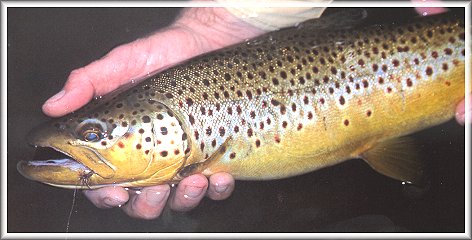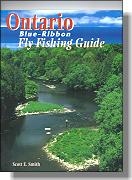The Blue-Ribbon Grand - Part 4
Hatches and Flies
By Scott E. Smith
The single most significant species of insect in the tailwater section of the
Grand River are net-building or filtering caddis. The abundance of algae in
the river make it ideal habitat for these insects. According to Ian Martin, an
entomology professor and author of Fly Fishing the Grand River,
the three most important caddis genera on the Grand are the spotted sedge
(Hydopsyche), the speckled sedge, (Cheumatopsyche),
and the little black caddis (Chimarra). The caseless, net-spinning
larval stage of these caddis are best imitated by several variations of the caddis
larvae nymph pattern in varying shades of green, with or without a bead head.
Fishing larvae patterns on smaller hooks, such as size 12-24 TMC 2487, 2457
or Daiichi 1130, is your best bet. The Elk Hair Caddis, Goddard's Caddis and
other basic caddis dries in varying colours and in sizes 18 through 12 are good
representations of these insects in their adult stage. Hatches of caddis occur
from early June through to the end of September, with the largest adults coming
off the water earliest in the season and reaching their peak in June.

I witnessed the sheer preponderance of these insects first-hand one evening
in June while fishing the low-level stretch (section 3) with Barney Jones. We
had been nymphing a group of large browns that we could see flashing in a nice
run between some flats and a large pool. I was about 8:00 p.m. and some caddis
could be seen flying around, but the hatch really hadn't come into fruition - at
least the fish weren't rising yet. I was busy tying on yet another small nymph
when Barney said, "Take a look at your waders." I looked down to see swarms
of caddis crawling up the legs of my waders. The entire surface of which, from
my thighs to the water level about kneww high, was solidly covered with insects.
If I wasn't a fly angler, I would have thought I was in a scene from a Hitchcock
flick and gone running up the bank thinking my fate had been somehow horridly
sealed. I realized after, that these caddis were not hatching at all, but in the
process of laying eggs. We noticed that our wading boots were covered in
caddis eggs when we changed at the car later that evening.

In order of abundance, isopods (sowbug) represent the next food group
for the browns. These are crustaceans, or shrimp-like organisms that do
not hatch into flying insects as caddis, mayblies and stoneflies do. They
vary in size from approximately size 22 to size 12, but are opaque in colour in
contrast to the bright green hues of caddis larvae. Scud patterns using plastic
or rubber backs are good prepresentations of the isopod, as are general-utility
nymphs such as the Gold Ribbed Hare's Ear Nymph.
One morning on the Grand in June, I began poking around on a small rock
island in the river just after the morning bite had subsided. I had noticed
several browns flashing in the shallows at daybreak, so I began turning over
stones in this particular area. On the bottom of a single soft-ball-sized stone
I observed two or three bright green caddis larvae, the same number of sowbugs,
and one Hendrickson nymph. I photographed some of them, but couldn't get
them all of them, but couldn't get them all as they were scrambling about in the
bright morning light trying to back into the water. This gave me an instant
appreciation of the abundance of food sources in the river.
For the dry-fly aficionado this stream is made-to-measure. The best dry-fly
fishing starts around mid-May and continues through July, until the algae
bloom reduces visibility. At this point some anglers turn to fishing large
crayfish streamers in the coloured water, while dry-fly anglers stick to
their guns and fish early morning Trico hatches and spinner falls. I fished
the Grand in August and enjoyed some productive mornings during this
hatch. My daughter Erin and I picked up several smaller browns on size
18 Griffith's Gnats fishing below the low-level bridge (Section 3).
To follow the hatch chronologically, the festivities begin in mid-May with
Hendricksons (Ephemerella), especially in the lower portion
of the tailwater. This is followed by the brown drakes in mid-June, with the foxes
and cahills (Stenonema), Isonychiaand Baetis,
coming off through June and July. In addition, a number of stonefly species that
were believed to be absent from this stream are now being found in the river.
This may be attributed to the ever increasing quality of the water in the system.

To arm yourself properly to conquer the Grand, here are the flies that John Valk
recommends as meat-and-potato dry flies for the river: Hendricksons, Cahills,
March Browns and Quill Gordons (orange-tinted hackle) in size 12-16; Blue-Winged
Olives in size 12 - 20; Deer Hair, Elk Hair; and Henryville Special Caddis in sizes 12
to 20; Brown and Green Drake patterns in size 8 - 12, and Tricos and Griffith's
Gnats in 16 - 22. ~ Scott E. Smith
From: Ontario Blue-Ribbon Fly Fishing Guide.We thank
Frank Amato Publications, Inc. for re-print permission!
|



